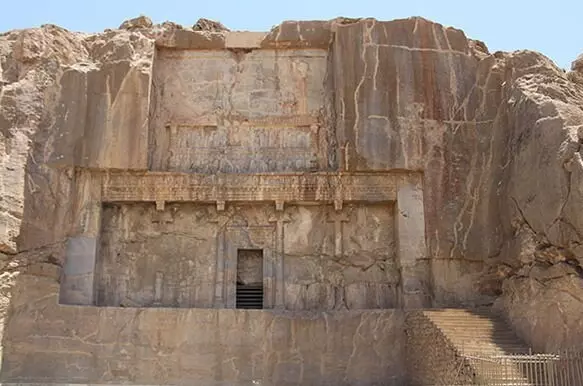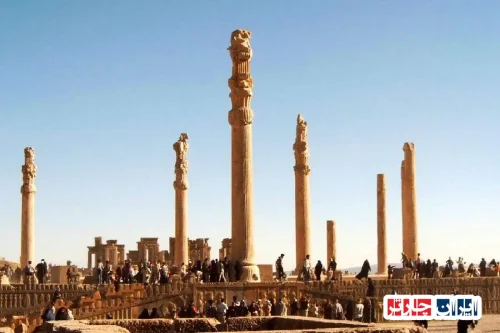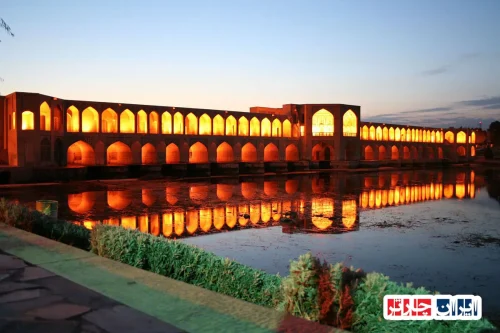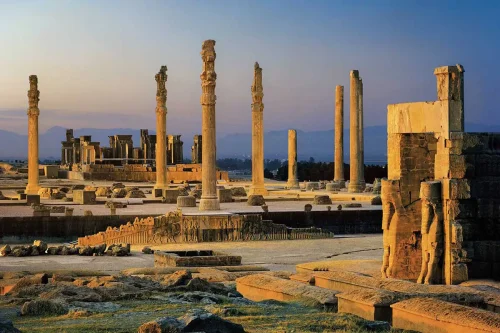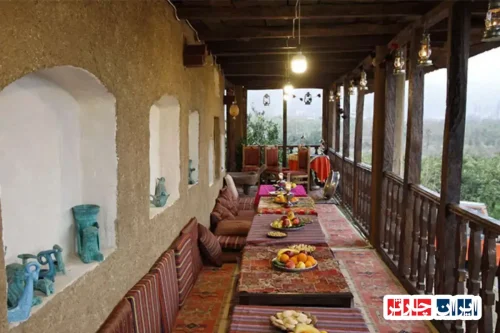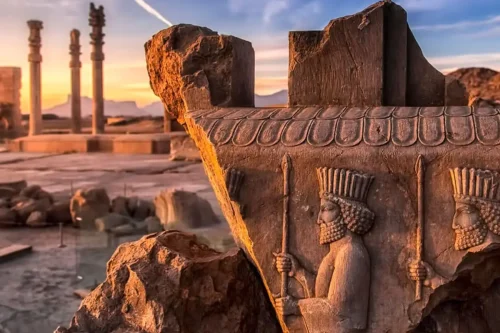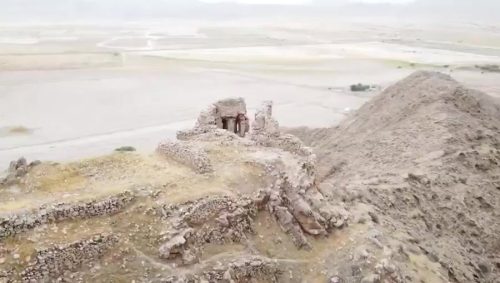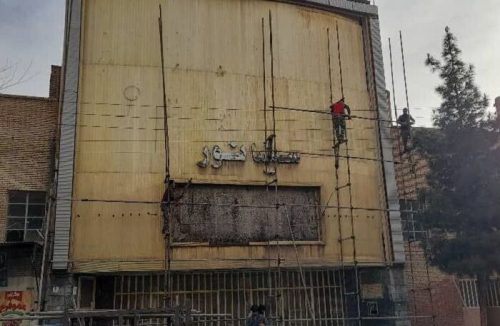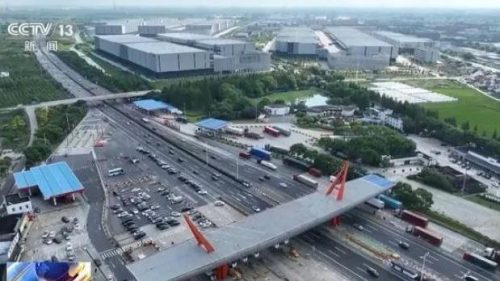News Source : https://www.irna.ir/news/85624691/%D8%B1%DB%8C%D8%B2%D8%B4-%D8%B3%D9%82%D9%81-%D8%A2%D8%B1%D8%A7%D9%85%DA%AF%D8%A7%D9%87-%D8%A7%D8%B1%D8%AF%D8%B4%DB%8C%D8%B1-%D8%AF%D9%88%D9%85-%D8%AF%D8%B1-%D8%AA%D8%AE%D8%AA-%D8%AC%D9%85%D8%B4%DB%8C%D8%AF-%D8%AA%DA%A9%D8%B0%DB%8C%D8%A8-%D8%B4%D8%AF
Collapse of the Roof of Artaxerxes II’s Tomb at Persepolis Denied
The Public Relations of Persepolis World Heritage Site has announced that the news of the collapse of the roof of Artaxerxes II’s tomb at Persepolis, which appeared on some online and print media, is not true. According to IRNA, the site emphasizes that evidence and expert analysis refute this claim. Expert investigations and examination of archived documents and photos indicate that the visible erosions on the roof and walls of the structure date back many years and that recent rainfall and this year’s spring has had no effect on potentially expanding damages to this world heritage site. Photos published in some media show sections of the roof experiencing erosion, indicating that these collapses are not recent.
According to protection plans and the transfer of mountain ravine waters to the outside surface behind the tomb roofs, exterior adobe structures were restored last year and the mountain ravine routes behind this tomb were drained and surface water directed to the exterior on both sides of the roof area. A rock scanning study using the GPR system is underway to identify water infiltration lines in the rocks of Mount Rahmat, with a sample already executed at the tomb of Xerxes at Naqsh-e Rustam. Thus, preservation and restoration operations never cease at the Persepolis World Heritage Site, and all actions are scientifically and strategically planned.
Consequently, the Persepolis World Heritage Site has stated it consistently supports and utilizes experts and cultural heritage enthusiasts and currently has extensive protection and restoration plans for Persepolis underway. Thus, the collapse of the roof of Artaxerxes II’s tomb at Persepolis has been denied and no new damage has occurred to this ancient monument.
This demonstrates the commitment of the Persepolis World Heritage Site to preserving and maintaining this region’s cultural and historical heritage, continually striving to prevent any damage and erosion from natural and human factors. Therefore, any suspicious reports of damage to these tombs must be verified by careful expert examination to ensure the accuracy of the information.
The Collapse of the Tomb of Artaxerxes II at Persepolis Denied – Historical Evidence
The Persepolis World Heritage Site has announced that existing historical evidence indicates that there has been no collapse of the tomb roof of Artaxerxes II at Persepolis. Detailed studies of ancient documents and archived images indicate the structural stability over the years. Experts have confirmed through scientific reviews that no changes in the tomb’s roof structure have been recorded, and existing damages to the roof are due to natural factors of previous years.
The Collapse of the Tomb Roof of Artaxerxes II at Persepolis Denied – Expert Analysis
Cultural heritage analysts emphasize that reports published in some media lack a scientific basis. Expert investigations have shown that the roof of the tomb of Artaxerxes II has not been affected by recent rains, and the observed changes are due to long-term natural erosion. These analyses clearly show that the tomb structure is in stable condition and does not cause any particular concern.
The Collapse of the Tomb Roof of Artaxerxes II at Persepolis Denied – Heritage Site’s Response
The public relations department of the Persepolis World Heritage Site has officially denied all claims about the collapse of the tomb roof of Artaxerxes II. The site added that it always strives to ensure the preservation and maintenance of this ancient monument using advanced technologies. Continuous protective measures indicate the site’s commitment to preserving the cultural heritage of this region.
The Collapse of the Tomb Roof of Artaxerxes II at Persepolis Denied – Document and Image Review
Investigations conducted by experts at the Persepolis World Heritage Site have analyzed archived documents and images. The results of these investigations indicate structural stability and the absence of recent collapse signs in the roof of the tomb of Artaxerxes II. The images clearly show that the eroded parts of the roof are due to long-term natural erosion, and no sudden collapse is observed.
The Collapse of the Tomb of Artaxerxes II at Persepolis Denied – Protective Measures
The Persepolis World Heritage Site has emphasized that continuous protective measures are being implemented to preserve the roof and walls of the tomb of Artaxerxes II. Key actions, including the redirection of mountain waterways and the upgrading of drainage systems, have been undertaken to prevent any new damage. These actions demonstrate the site’s commitment to protecting this ancient monument.
The Collapse of the Tomb of Artaxerxes II at Persepolis Denied – Expert Conclusions
Expert reviews indicate that the roof of the tomb of Artaxerxes II at Persepolis has not been affected by natural factors of previous years. Experts, through precise analysis of the existing data and documents, have assured that no sudden collapse in the structure has been observed, and the structure is well-preserved. According to specialists, these conclusions provide a foundation for alleviating public concerns.
The Collapse of the Tomb of Artaxerxes II at Persepolis Denied – Community Reaction
The Iranian cultural heritage community has reacted positively following the announcement by the Persepolis World Heritage Site. Many experts and enthusiasts in the preservation of ancient monuments have supported the validity of this announcement and encouraged the continuation of protective activities. These reactions reflect the high importance and value of cultural heritage to society.
The Collapse of the Tomb of Artaxerxes II at Persepolis Denied – Future Plans
The Persepolis World Heritage Site has announced extensive plans for the preservation and restoration of the tomb of Artaxerxes II. These plans include periodic reviews, updates to protective technologies, and collaboration with international cultural heritage preservation organizations. The main goal is to ensure the preservation of this ancient monument for future generations.
The Collapse of the Tomb of Artaxerxes II at Persepolis Denied – Importance of Heritage Protection
Protecting ancient monuments like the tomb of Artaxerxes II at Persepolis plays a crucial role in preserving the cultural and historical identity of the country. The World Heritage Site is aware of the high importance of maintaining and restoring these monuments and strives to preserve this heritage through scientific and managerial programs. These efforts contribute not only to the country’s culture and history but also to the region’s tourism and economy.
FAQ
- Has the roof of the tomb of Artaxerxes II at Persepolis collapsed?
- No, the report of the collapse of the tomb roof of Artaxerxes II at Persepolis published in some media has been denied by the public relations of the Persepolis World Heritage Site.
- Which organization is responsible for validating the news?
- The public relations of the Persepolis World Heritage Site was responsible for announcing the validity and denial of the roof collapse news.
- What are the reasons for denying the collapse news of the tomb roof?
- Expert reviews and analysis of archived documents and photos indicate that the roof anomalies are related to distant years and recent rains have had no impact on the damages.
- Have recent rains affected the roof of the tomb?
- No, the recent years’ and this spring’s rains have not had any impact on the potential spread of damages to the roof of the tomb of Artaxerxes II.
- What information do the published images regarding the tomb roof provide?
- The images show that parts of the roof are eroded, but these erosions are not related to recent years and are signs of time passage.
- Where is the tomb of Artaxerxes II located?
- The tomb of Artaxerxes II is located at Persepolis, carved into the rock of the mountainous Kuh-e Rahmat.
- How is the roof of the tomb constructed?
- The roof of the tomb is made of arched vaults cut from the mountain.
- How is water infiltration into the tomb prevented?
- Protection plans include redirecting mountain waterways outside and draining surface water to the outer section.
- What actions have been taken to protect the tomb?
- Extensive restoration of the tomb facade, stabilization and strengthening of the facade motifs, and drainage of mountain waterways are among the protective measures taken.
- How is the monitoring program of Persepolis tombs?
- The tombs monitoring program, as an important part of the restoration and protection program, is carried out permanently.
- What technologies are used to detect water infiltration?
- Rock scan studies using GPR system to detect water infiltration veins are underway.
- Have preservation and restoration operations been halted at any time?
- No, preservation and restoration operations continue continuously at the Persepolis World Heritage Site and are never halted.
- What architectural features does the tomb of Artaxerxes II have?
- The tomb of Artaxerxes II features stone sarcophagi within the rock and a ceiling of arched vaults cut from the mountain.
- What are the future plans for Persepolis preservation?
- The Persepolis World Heritage Site is executing extensive plans for the preservation and restoration of Persepolis.
- What measures have been taken to prevent moisture penetration?
- Guide surface water to the outer section on both sides of the roof and drain mountain waterways are measures taken to prevent moisture penetration.
- What are the names of other similar preserved tombs?
- The tomb of Xerxes at Naqsh-e Rostam is an example of tombs included in rock scan studies with the GPR system.

